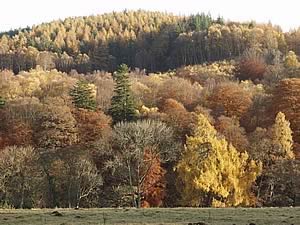2010-12-23
Landowners in the Yorkshire and the Humber region are being offered cash to plant more trees to lessen the impact of floods and climate change.
The Forestry Commission and Yorkshire Forward have created two new grants that will be available until 2013 in a bid to protect existing woodland and create new areas.
Phill (correct) Hibbs has been seconded from his job as Wildlife Conservation Officer with the Yorkshire Dales National Park Authority to become one of two dedicated Support Officers who will help oversee the introduction of the grant schemes.
“The grants will help to fulfil objectives within the Regional Forest Strategy with regards to climate change and flood alleviation and we are hoping they will really make a difference,” he said.
The Forestry and Flooding Initiative grant focuses on creating new native woodlands to help reduce problems associated with flooding. Woodland creation has been targeted at specific locations where trees can make a reasonably significant contribution to reducing flood risk.
A suitability map has been produced that shows the areas of land on which the Forestry Commission would like to see new native woodlands being created to reduce downstream flooding. Anyone wanting to create a new native woodland within the areas shown on the suitability map may be eligible to claim an additional contribution of £2,000 per Ha, on top of the existing Woodland Creation Grant of £1,800 per Ha.
The Woodland Improvement Grant 80 aims to reverse the decline of undermanaged ancient and native woodland – some of our richest wildlife habitat.
For many species of animals and plants, ancient woodland is their sole habitat and is the UK's equivalent of rainforest, home to more rare and threatened species than any other UK habitat. For these reasons it is often described as an irreplaceable resource.
It is considered that some of the main threats to ancient and native woodland are:-
- Over grazing by sheep, deer and rabbits, leading to changes in the woodland structure, deterioration of the ground flora and difficulties with regeneration.
- Increased shading by Sycamore and other non-native species, leading to changes in the composition of the woods.
- Woodland neglect or a decline in traditional management practices, such as coppicing may also lead to a reduction in the structure of the woodland.
The Forestry Commission has identified which woodlands within our region have the greatest potential for biodiversity gain and have produced a targeting map.
Woodlands on the map that are either coloured red or yellow would be eligible for the enhanced Woodland Improvement Grant, which will be paid at 80% of standard costs for agreed works and items.
Andrew Colley, the National Park Authority’s Member Champion for Conservation of the Natural Environment, said: “This is a great opportunity for landowners within the National Park to create new broadleaved woodlands, and restore existing woodlands, which will not only help enhance the biodiversity of the National Park, but will increase and protect this valuable habitat for future generations.”
Landowners who need information about the grants or advice and help to develop their proposals and submit applications should contact either Phill Hibbs on 01756 751607 or his colleague Andrew MacDermott on 01765 609355.
 Lloyds Banking Group Appoints Adam Henson as Farming Ambassador Lloyds Banking Group Appoints Adam Henson as Farming Ambassador
 Building Firm to Act Fast on Collapsed Building Quotes Building Firm to Act Fast on Collapsed Building Quotes
 Which Renewable Technology is the Right FIT? Which Renewable Technology is the Right FIT?
|



